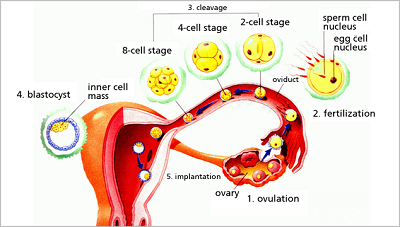Due to injury or infection, a fallopian tube will be filled with severe or clear fluid, that is hydrosalpinx. Usually both fallopian tubes are affected by hydrosalpinx. The blocked tube may become substantially distended giving the tube a characteristic sausage-like or retort-like shape. The affected tubes may reach several centimeters in diameter and the condition is often bilateral. The blocked tubes cause infertility and pregnancy is usually only achieved with In Vitro Fertilization. IVF bypasses the tubes altogether.

Hydrosalpinx Causes
A long-untreated infection in the fallopian tubes or the pelvic infection can often cause hydrosalpinx. gonorrhea, chlamydia, staphylococcus, streptococcus and pelvic tuberculosis are the most common bacteria at fault. Fallopian tube infection may led by a number of situations, including:
The residual effects of chlamydia or gonorrhea, a prior sexually transmitted disease
Excessive tissue buildup due to endometriosis
Hydrosalpinx Symptoms
Usually hydrosalpinx has no symptom, but sometimes women with hydrosalpinx will have uncommon pain. But if woman have, the symptoms commonly are:
Lower often recurring abdominal pain or pelvic pain
Infertility is a common symptom as tubal function is impeded
Hydrosalpinx Dianogsis
Ultrasound
Into the vagina, inserting a confined needle during this procedure. By using sound waves with high or sonar frequency, this diagnostic method can show us a picture of fallopian tubes which is real time image. Usually on an ultrasound, fallopian tube is invisible but filling a tube full of fluid will become bigger and like a sausage. In the original assessment of the fallopian tubes, uterus and ovaries is brief, non-invasive and painless, ultrasound is often used.
Hysterosalpingogram (HSG)
A hysterosalpingogram or known as HSG is a procedure with an thing called x-ray, that is used to see whether the fallopian tubes are open or blocked and if the inside of the uterus (uterine cavity) is normal. HSG usually takes 5 to 10 minutes to perform and is performed in the 2nd week of the menstrual cycle, it is an outpatient procedure.
A little dye put through a thin tube that is put through the vagina and into the uterus when perform this test. The dye will flow into the tubes because the uterus and the fallopian tubes are hooked together. It is easy to see any blockage and visualize as the dye disperses through the uterus. The tubes will become expanded and the dye can’t exit the fallopian tubes and If there is blockage.
Laparoscopy
Laparoscopy is a procedure in surgery by putting a thin and lighted tube that fitted by a very small viewing camera through a cut in the abdomen to observe the abdominal organs or the female pelvic organs. This treatment is usually used to find or confirm problems such as a hydrosalpinx diagnosis in the past, cysts, adhesions, fibroids, and infection. It is often not taken for the first diagnosis since it is a procedure in surgery general anesthesia is needed. For minor surgeries, laparoscopy can be less stressful and may have less problems and lower costs than laparotomy. It can often be done without staying overnight in the hospital.
Hydrosalpinx Treatment
1. Medications
Herbal medicine, which isn’t common for patients with hydrosalpinx, is an effective treatment. Herbal medicine has its own advantages on curing this condition. Hydrosalpinx is commonly caused by toxic materials, sluggish Qi and blood circulation, weak immunity and so on according to the TCM view of TCM. So lots of functions of signal herbs are highlighted and some useless functions are offset by adding different herbs in. Herbal medicine can eliminate hydrosalpinx totally. Fuyan Pill is one of the most frequently used herbal medicines.
2. Surgery
Women can repair this tubal condition with surgery under some circumstances, particularly where the hydrosalpinx is not big, which pregnancy to occur naturally is allowed. Neosalpingostomy, in which inserting a laparoscope surgically into the abdomen and make the blocked fallopian tube to be opened by an incision. It is relatively rapid to recover from this procedure and within a few days may normal activity be resumed. For younger patients who can afford the additional wait time, because ovarian health and egg quality decline after the age of 35, reversal surgery is more viable. After tubal surgery, for a possible ectopic pregnancy, patients conceiving must be monitored very closely. In the fallopian tube instead of the uterus, the fetus grows and implants, this is a potentially serious situation.
3. In Vitro Fertilization (IVF)
The most efficient and cost effective way to conceive is to bypass the obstruction if a hydrosalpinx is the obstacle to conception. In vitro fertilization (IVF) takes the egg out of the body for fertilization by sperm in a petri dish. After a few days, the embryo is gently transferred into the uterus. In effect, in vitro fertilization is nothing more than replacing the functions of the fallopian tube. It is the most effective way for a patient with a hydrosalpinx to get pregnant.
4. IVF success is lowered by hydrosalpinx
A negative influence on the embryos can be caused by toxins in the hydro fluid Reduced implantation potential by altering the receptivity of the uterine lining
Reduced implantation by altering uterine contractility patterns
Fluid from the tubes causes a mechanical flushing effect on the embryos
The mechanism for reducing pregnancy rates with hydros has not yet been proven - it may be due to a combination of factors.
5. Improve the rate of IVF
It may be recommended that the damaged portion of the fallopian tube be removed entirely before treatment in order to increase IVF success and a healthy pregnancy, as in some cases, fertility enhancing drugs may have the adverse effect of causing fluid buildup in the fallopian tubes. Blocked, fluid-filled tubes also can leak into the uterus, posing a risk of infection after embryo transfer. You can also try herbal medicine to improve the condition of the whole pelvic cavity if you don’t want to remove the fallopian tubes.

